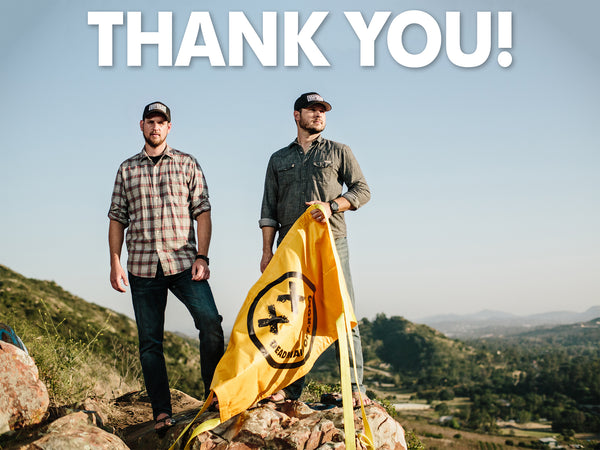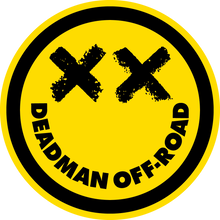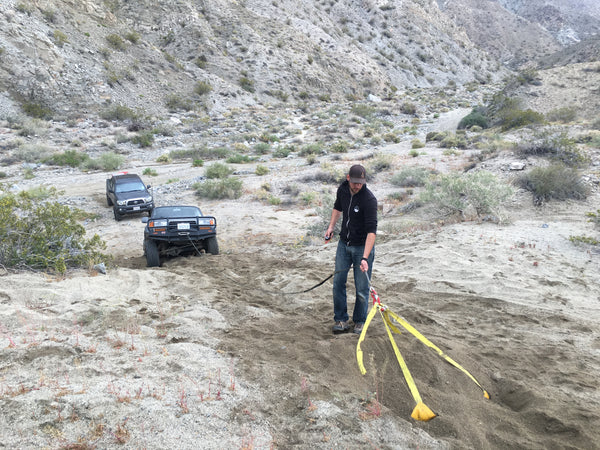
Never forget how you got here...
We’ve been getting a lot of credit in the media lately, a phenomenon that we’re not used to. The way this Deadman business is being presented makes it seem as though we got here all on our own… Frankly, this couldn’t be further from the truth. We’re the beneficiaries of the help and assistance of more friends, family, and other like-minded companies than we may ever know. We are blessed – we are not alone, and we have so many friends to thank. This blog post is our feeble attempt to give credit to some of these friends, highlighting the valuable role they played in the creation of the Deadman.
Deadman Origins
Everyone is familiar with the axiom, Necessity is the mother of invention, and in the case of the Deadman it proved to be true. As avid off-roaders based in the desert of Southern California, we had a problem: creating a winch anchor point where there was nothing but dirt to anchor to. Current solutions at the time were large, heavy, bulky, and expensive and we didn’t have space to accommodate such anchors. Living in San Diego and wheeling mostly in the desert of Anza-Borrego, this problem first hit home for Bryant and his good friend, Jason Young. Both had vehicles equipped with winches, yet with no trees and few rocks to safely anchor to in the desert, self-recovery proved to be very challenging. So they set out to find something lightweight, compact, and affordable, quickly learning that nothing of the sort existed. While the two friends were brainstorming ways to fill this need, Jason mentioned hearing how, “back in the day,” the Bronco guys would attach their winch lines to a sand bag and bury it deep in the ground. Using this as inspiration, development for the Deadman began.
Bryant and Jason quickly abandoned the idea of filling and burying an actual bag. While this method had been proven, it was also tedious, boring, and difficult as one must dig a rather deep hole for it to be effective. Furthermore, once the vehicle had been recovered, one must dig again to retrieve the bag and unhook the winch line. Putting his engineering background to work, Bryant began toying with the idea of using an open fabric that would act like a parachute, creating drag when buried. This design would create a larger footprint within the ground, theoretically making it more effective at shallower depths, while also giving one the ability to pull it out post-recovery without digging again – a huge benefit, if it could be achieved! With this new design, nothing more than a concept on paper, he was ready to create the first working prototype. With a family connection to the industrial sewing industry, Jason introduced Bryant to Bracken, the foreman for Southland Enterprises, and set a meeting to begin discussing his ideas. Conveniently local, Southland had the machines and expertise to help develop a series of original prototypes. The very first Deadman prototype created with Southland was manufactured from heavy-duty canvas and several Harbor Freight straps. With his fresh new Deadman in hand, Bryant conducted a quick proof-of-concept by burying it in a field near his home. This initial test involved placing his ’08 Jeep Wrangler JK in neutral with the Deadman buried in less than 2’ of Southern California dirt. It worked! The Deadman held tight, allowing Bryant’s winch to drag his JK across the field. With the excitement of the initial proof-of-concept still fresh, the duo began to plan for future testing in their target environment: soft desert sand.
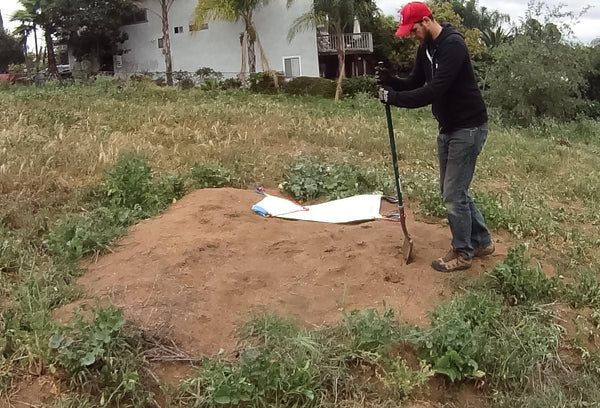
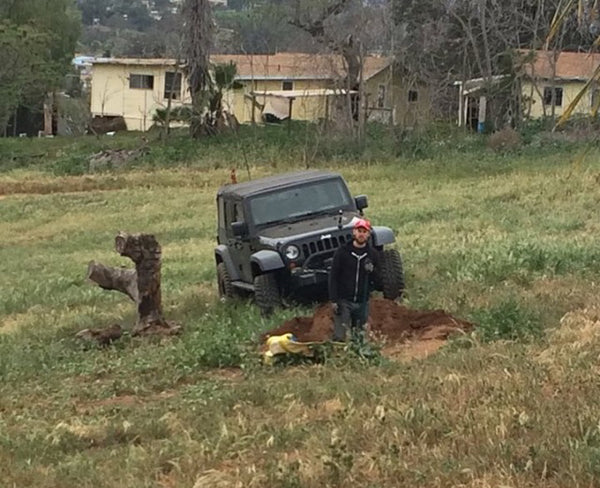
Bryant and Jason were both busy husbands and fathers with demanding jobs and responsibilities; it took several months for the next round of testing to begin. Eventually, with schedules cleared and a free weekend ahead, the two headed out to the desert to finally test their Deadman prototype in the sand. They buried Bryant’s Jeep up to its axles in the soft sand of the Anza-Borrego desert, creating a genuine recovery situation. However, the sand proved to be more difficult to anchor to than the soil near his home. Despite multiple attempts, the Deadman would not raise the vehicle, resurrecting itself from its own grave instead. Though Bryant could feel the nose of his Jeep dive under the load of the winch, the Deadman simply didn’t have enough capacity to recover the Jeep on its own. Tempted to give up, Bryant & Jason decided to conduct one final test with the Jeep in gear, creating a vehicle assisted recovery instead of a dead-pull in neutral. This time the Deadman held just enough to allow the Jeep to climb out of the hole! So while the Deadman did not have enough holding power to recover the Jeep in neutral, it did have enough to assist the Jeep, giving it the traction it needed to climb out. Armed with their new knowledge from the weekend’s experimentation, they headed home – and back to the drawing board.
Production & Testing
Over the next few months, the Deadman’s design evolved as they incorporated what they had learned in the desert. They began researching materials, trying to find better fabrics for their next batch of prototypes. Being family men, Bryant and Jason – flanked by a small army of 7 children under the age of 8, and accompanied by their gracious and patient wives – spent hours looking over bulk rolls of fabric, selecting various samples. Overwhelmed by a wide array of options, they consulted Rich Young (Jason’s father), a wise man with many years’ experience in the industrial sewing industry, and the fine folks at Southland. With their help, they selected stronger and more durable materials. The next set of prototypes would be manufactured with a heavyweight industrial vinyl fabric for the parachute, offering durability and flexibility, and Class V 2” polyester tow-strap for the lines, due to its low-stretch properties.
With these changes in place, the two continued to test and improve their design. The materials proved to be very durable, capable of carrying far more capacity than they could achieve in ground applications. Furthermore, because the Deadman’s design had evolved to include its arms and legs (as they came to address the top and bottom leads), they realized that it could be a useful tool in other recovery situations, too, such as anchoring to rocks and trees, or simply being a ground mat when working on the vehicle. So what began as an exercise to create a lightweight, stowable ground anchor had become a much more interesting and valuable exercise. Still, the Deadman’s effectiveness in the ground wasn’t reliable enough to be a truly dependable off-road recovery anchor… it would often unearth itself before the vehicle was recovered.
The next breakthrough came during a trip Bryant took with his longtime friend, Daniel, to Joshua Tree National Park. Knowing there was an unresolved problem with the parachute design, Bryant needed to do more testing. Because the two leads furthest from the vehicle were naturally engaged first as the winch began to pull, the Deadman would roll forward, largely unearthing itself until the leads closest to the vehicle were also engaged. At this point, with all four leads equally engaged, the anchor began to work, providing sufficient capacity to recover the vehicle. It seemed that the only way to overcome the phenomenon would be to bury the Deadman much deeper, yet this additional digging would make the Deadman more difficult to use and would certainly be a deal-breaker for many… He needed a way to make the Deadman work reliably at a shallower depth.
While observing a recovery, Daniel suggested using a metal shackle to effectively shorten the front leads. If it were possible to attach the rear leads behind the front leads, the imbalance would be offset and the four leads should pull together in unison. So they wrapped the front leads around a shackle and attached the rear leads to it; the anchor immediately became more effective, allowing Bryant to recover his Land Cruiser using a much shallower hole than before. This new method was tested repeatedly over the next few months and found to be very reliable, yet it required techniques which weren’t necessarily safe. As the two began testing the anchor together, Daniel suggested a change in the overall design through the creation of the double-loop splice. Adding secondary loops to the product itself would allow one to offset the rear leads without using a metal shackle, simplifying the anchor and eliminating metal from the system, thereby making it lighter and safer overall.
Getting to Market
At the end of 2016, Bryant felt confident that the Deadman design was ready for market – it was now or never! He and Jason returned to the desert for a final round of testing, armed with a small pile of Deadmen, which Rich had kindly volunteered to sew together. With a functional and reliable prototype, they needed to know its limitations. Prepared with a list of scenarios, the two were amazed as the Deadman performed flawlessly in every test case they put it through. Riding a high wave of excitement, Bryant knew that starting a legitimate business was the next step in getting the Deadman into the hands of others. However, Jason, several years in to his own business startup, had a full plate and could not commit to another endeavor. Graciously stepping aside, he advised Bryant to move forward on his own, encouraging him to pursue his longtime dream of starting and owning his own small business. Thus, he encountered his next challenge: he didn’t know how to start a business or take a product to market. Like so many other entrepreneurs, he was well-qualified to solve a specific problem and create a valuable solution, but “business” was uncharted territory. Having been a mechanical engineer for well over a decade, he knew how to design and engineer a safe and capable product, but he needed help getting to the next stage.
Daniel and Bryant go way back, their paths weirdly crossing repeatedly since the late ‘90s. At the beginning of 2017, after a couple of months of seeking advice while slowly trying to build the business, Bryant reached out to Daniel for business mentorship. A friend and fellow off-roader, Daniel was a “business guy,” having spent his career taking software products to market for many years. Due to M&A activity in his industry, Daniel found himself in possession of two of the key ingredients of opportunity: time and (a little!) money. Armed with a product, a window of time, and valuable experience, the two friends leveraged the opportunity and their shared passion for the outdoors to create Deadman LLC. Finally paired together, the two quickly kicked things into gear. They built a launch plan around a Kickstarter campaign that would begin at the same time as a major industry event, Overland Expo West, allowing them to gain maximum exposure, and set the wheels into motion. This would allow them to raise the capital they needed to manufacture the Deadmen, while also making a big splash in the industry. Through a lot of hard work and focus, the two made their planned launch date, ran a successful Kickstarter campaign, and are well into production now.
Starting a Business is a Team Sport
Looking back at the incredible ride of the last few years, it’s both surprising and gratifying to see how far the original idea has come. While we, Bryant and Daniel, are the face of the company today, there are many around us who deserve credit and thanks as well; without their help and support, we would not have made it this far. We are grateful to our Creator and all that He has provided to get us here. We also owe a HUGE “Thank you” to our wives, our biggest cheerleaders and encouragers. Without their support and abundant patience, particularly over the last six months, this would still be a hair-brained idea. We’re so appreciative of our kids for putting up with distracted and absentee fathers during this busy and crazy season (you were a big help with all your great ideas!). We want to give a big shout-out to Jason Young for his inspiration, advice, and friendship – it was a blast to work on this with you! To the wonderful people at Southland Enterprise, particularly Bracken, we appreciate your invaluable insights into the initial design and assembly of the first Deadman prototypes. Furthermore, without your generous donation of time in the assembling of the first few prototypes, this may still be a science project rattling around in our heads. To Rich Young: thank you for your support, guidance, and hard work and time you put into making many of our prototypes, giving us the ability to work through all the kinks we discovered in the design. Thank you to our families, for your encouragement and prayers throughout. Thank you to Aaron Dodell, Tyler & Satin Pelfrey, Michael Meir, 7P International, Yeti & Yolo, Justin Andrews, Rhett, Rogue Overland, Scott Hoyt, Jason Lau, Jason Farr, Mark Gist, Todd Plate, Krazy Beaver Tools, Defconbrix, Chris Hershman, Erick Frost, Riley Phillips, and the rest of the many friends we’ve made along the way for your generous help, support, and advice. Finally, we wish to say Thank you to everyone who backed us on Kickstarter! Without your trust in us and our product, we would not be in production today. We are truly thankful and indebted to you all!
